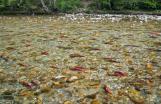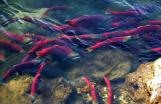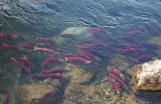1
The riverbed from Shuswap Lake to the source of the Upper Adams River was always a major spawning ground for sockeye salmon. The fall spawn in the Adams River coincided with the frequent log drives that took place each year. Salmon attempting to return to the Upper Adams River found their passage completely blocked. Even salmon which normally spawned in the Lower Adams River were affected.3
In 1907, the Adams River Lumber Company constructed a rock-filled timber-crib splash dam at the head of the Lower Adams River. The dam maintained the level of Adams Lake until the sluice gates were released which supplied enough water to float the logs down to Shuswap Lake. This dam had a long-reaching severe environmental impact on the sockeye salmon run.5
"The salmon didn't stand a chance of spawning effectively, for they were carried downstream with the flood each time it was released. In between floods the stream bed was nearly dry, and in winter the eggs were exposed and frozen..." as reported by the International Pacific Salmon Fisheries Commission in 1958.7
With the closure of the Adams River Lumber Company in 1925, the sluice gates were left closed. The absence of log drives allowed the spawning population to re-build in the Lower Adams River, however, it wasn't until the dam was destroyed in 1946 that the salmon once again spawned in Adams Lake and its tributaries. It took over 50 years for the spawn to regain its impressive numbers.In 2010, the salmon spawn in the Adams River was one of the largest in over 100 years.



